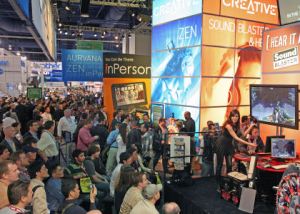Jim Barry is like the old wise man of tech. Every year, he tours the country with his gadgets and encourages people to come to the sprawling tech trade show, International CES, commonly known as the Consumer Electronics Show, every January in Las Vegas.
The Consumer Electronics Association, which puts on CES, calls Barry the Digital Answer Man. The former tech journalist (and current face of the CEA) visits the media with his gadgets and stirs up interest in consumer electronics. I was quite disappointed that he didn’t actually haul a big pile of gadgets in front of me this year, as he said, “You’ve seen all this stuff.” Barry has a good eye for what’s new because he gets to look at a ton of products for a living.
We caught up with him in a recent interview in Silicon Valley. Among the interesting topics: CES will feature more than 200 companies in its Eureka Park startup zone this year, about double its size last year. I enjoyed talking with Barry because he always likes to stroll down the memory lane of technology as he explains the new stuff.
VentureBeat: So you’re getting ready for the next CES. What is catching your attention?
Jim Barry: I’m very struck at how much convergence has actually happened. A quarter of TVs being sold now are smart. It’ll probably be half of them in a couple of years, in households. I’ve been writing about convergence since 1991 when I was at Video magazine. But it’s finally starting to happen. It won’t be long. Wireless HDMI is really important.
VB: Are things like DLNA — the Digital Living Networking Alliance — making convergence happen, or are other things taking root?
Barry: All of these wireless technologies are finally getting to the point where they’re really good. The conventional wisdom used to be, you can have something wired and you’ll get everything up to what the best golden-eared audio guys would like, or if you want to do wireless, yeah, it’s handy, but the quality’s just not there. Now the quality is finally getting there.
VB: It seems like Bluetooth is good for some things, but the wireless HD video part has had to wait.
Barry: Yeah, it has to have more bandwidth. Here’s the thing, though. You can go all the way back to cordless phones. There’s always been that paradigm, that phenomenon. People like not being tied to one place. They like not having cables running all over their house. That’s proven. When the quality gets to the point where the Lucases and the THX guys and all the rest say, “This is good enough for us,” it will be good enough for everyone. That’s coming.
VB: You think that the new game consoles are going to do well. Can you say more about what you think of the new consoles?
Barry: Again, the quality will be there. These are pretty serious computers. And the game makers, the software guys, are promoting software more heavily than I’ve ever seen. I’ve been watching a lot of baseball the last couple of weeks. I don’t ever remember seeing so many ads for video games – for Call of Duty and Grand Theft Auto and all the rest. GTA has other issues, but nevertheless, I think that experience, that immersive experience they’re talking about, is going to spur those sales. As you said before, they can certainly coexist. It’s a different experience playing one of those, compared to playing anything on a handheld device. Absolutely anything.
Another thing I think will help with that is Ultra HD. That’s another immersive experience. You can get right up close to it or sit away from it, and it has a lot of the benefits of 3D without the glasses.
VB: What you said there was interesting. You suggest that marketing really matters in these categories.
Barry: Marketing always matters. It matters in varying degrees. But also, marketing and timing matters. Wireless HDMI has been nascent for a long time. I go back to 12 years ago now, when Apple introduced the iPod. MP3 players had been around for five or six years before that. They had lots of issues, not the least of which were the legalities. But Apple made it very clear that it was cheap, it was legal, and it was easy. Plug it in, you’re done. Then, they overlaid the fashion and lifestyle marketing. And now they still own virtually 100 percent of the MP3 market.
So, back to your question: Marketing is definitely important. Marketing and timing is important. Also, to me, if you want to get something into the mass market, you have to have that ease of use, that simplicity. Even the VCR, which for its entire lifespan was the butt of jokes about how nobody could program it. What everybody could do was get a tape, pop it in, and watch a movie. Many of the features were underutilized, if used at all, but it was easy to use for that. It had a real benefit. Watch whatever you want when you want, providing your video store had it.
Now that ease of use has been taken several steps further forward with Netflix. What’s the number now? On a given evening, Netflix uses 25 percent or 30 percent of the bandwidth on the Internet? Again, there is something that people want. If you want to get really fundamental, people want to learn something, or they want to be entertained, or they want to play a game. Those are fundamental things that all this technology facilitates in different ways, through a lot of different experiences.
VB: I’m curious what you think about the way the new game machines are being marketed. There’s been this discussion in the game industry about how to do this right. Nintendo, with the Wii, captured a lot of nongamers. It failed at that with the Wii U. But now Microsoft and Sony are coming out head-to-head, and Microsoft’s messaging from the start was a lot more like, “This is a broader entertainment system for everyone in the house to use.” It had the voice commands for changing TV channels and things like that. Sony has said, “This is all about games for us.” Sony CEO Kaz Hirai said that unless you get the console into the hands of the hardcore gamers first, the other stuff the box can do won’t get noticed. Their initial marketing is almost entirely targeted at those hardcore gamers, while Microsoft has talked to a broader market from the very beginning.
Barry: This is probably reflective of Microsoft—It goes way back to their desire to control the living room. It’s certainly not by accident that the game consoles, over the previous generation of the Xbox 360 and the PS3, were also streaming video. They were set-top boxes that did other things.




